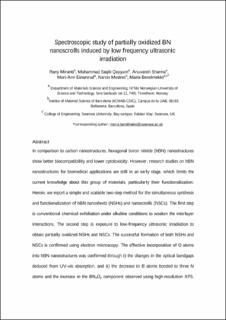| dc.contributor.author | Miranti, Rany | |
| dc.contributor.author | Qayyum, Muhammad Saqib | |
| dc.contributor.author | Sharma, Anuvansh | |
| dc.contributor.author | Einarsrud, Mari-Ann | |
| dc.contributor.author | Mestres, Narcis | |
| dc.contributor.author | Benelmekki, Maria | |
| dc.date.accessioned | 2020-09-29T06:44:41Z | |
| dc.date.available | 2020-09-29T06:44:41Z | |
| dc.date.created | 2020-09-22T15:24:20Z | |
| dc.date.issued | 2020 | |
| dc.identifier.citation | Applied Surface Science. 2020, 515 146055-?. | en_US |
| dc.identifier.issn | 0169-4332 | |
| dc.identifier.uri | https://hdl.handle.net/11250/2680085 | |
| dc.description.abstract | In comparison to carbon nanostructures, hexagonal boron nitride (hBN) nanostructures show better biocompatibility and lower cytotoxicity. However, research studies on hBN nanostructures for biomedical applications are still in an early stage, which limits the current knowledge about this group of materials, particularly their functionalization. Herein, we report a simple and scalable two-step method for the simultaneous synthesis and functionalization of hBN nanosheets (NSHs) and nanoscrolls (NSCs). The first step is conventional chemical exfoliation under alkaline conditions to weaken the interlayer interactions. The second step is exposure to low-frequency ultrasonic irradiation to obtain partially oxidized NSHs and NSCs. The successful formation of both NSHs and NSCs is confirmed using electron microscopy. The effective incorporation of O atoms into hBN nanostructures was confirmed through (i) the changes in the optical bandgaps deduced from UV–vis absorption, and (ii) the decrease in B atoms bonded to three N atoms and the increase in the BNxOy component observed using high-resolution XPS. Raman spectroscopy was used to analyze the evolution of the active phonon modes upon further exposure to irradiation, and showed a phase transition from sp2 to a mixture of sp2–sp3 bondings at the occurrence of the shape transformation from NSHs to NSCs. | en_US |
| dc.language.iso | eng | en_US |
| dc.publisher | Elsevier | en_US |
| dc.rights | Attribution-NonCommercial-NoDerivatives 4.0 Internasjonal | * |
| dc.rights.uri | http://creativecommons.org/licenses/by-nc-nd/4.0/deed.no | * |
| dc.title | Spectroscopic study of partially oxidized BN nanoscrolls induced by low frequency ultrasonic radiation | en_US |
| dc.type | Journal article | en_US |
| dc.type | Peer reviewed | en_US |
| dc.description.version | acceptedVersion | en_US |
| dc.source.pagenumber | 146055-? | en_US |
| dc.source.volume | 515 | en_US |
| dc.source.journal | Applied Surface Science | en_US |
| dc.identifier.doi | 10.1016/j.apsusc.2020.146055 | |
| dc.identifier.cristin | 1832209 | |
| dc.relation.project | Norges forskningsråd: 275139 | en_US |
| dc.relation.project | Norges forskningsråd: 245963 | en_US |
| dc.description.localcode | "© 2020. This is the authors’ accepted and refereed manuscript to the article. Locked until 13.3.2022 due to copyright restrictions. This manuscript version is made available under the CC-BY-NC-ND 4.0 license http://creativecommons.org/licenses/by-nc-nd/4.0/ " | en_US |
| cristin.ispublished | true | |
| cristin.fulltext | postprint | |
| cristin.qualitycode | 1 | |

